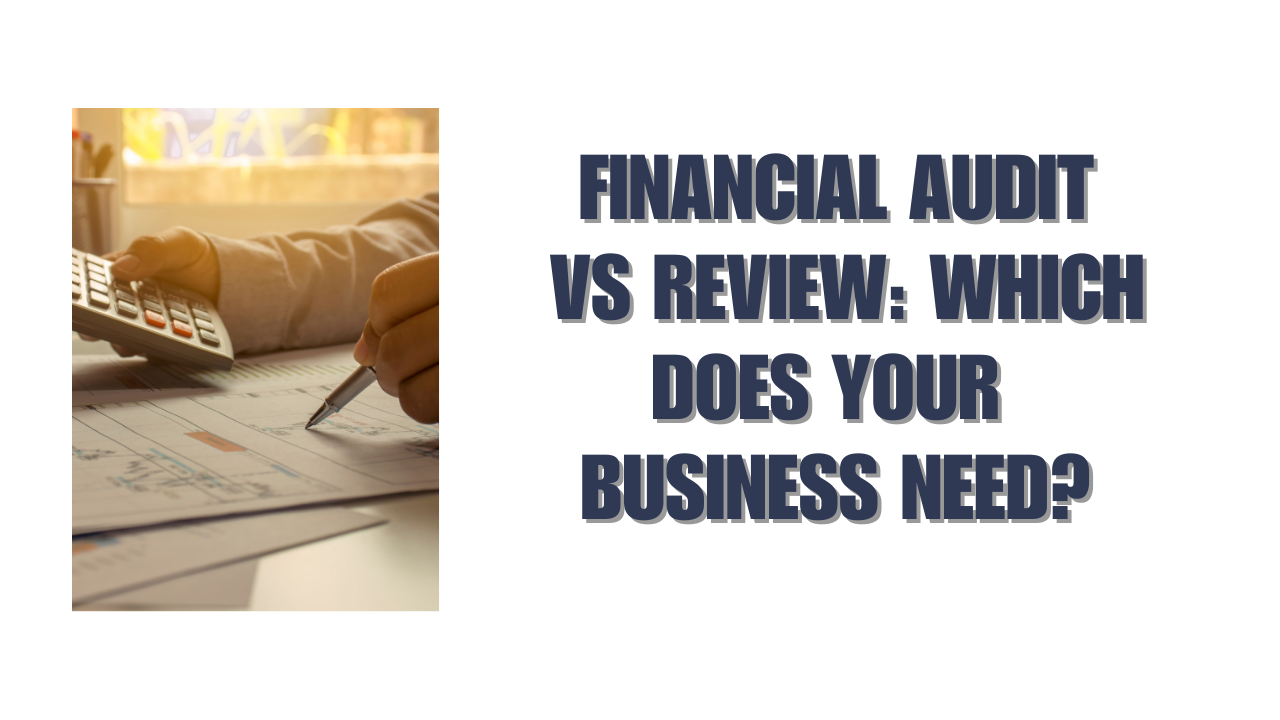For business leaders, making the right choice between a financial audit and a review can be confusing. Both provide valuable insight into a company’s financial health, but they serve different purposes, carry different levels of assurance, and have distinct regulatory implications. Understanding the differences is crucial for informed decision-making, regulatory compliance, and long-term business strategy.
What Is a Financial Audit?
A financial audit is an in-depth examination of a company’s financial statements and related processes. Its primary goal is to provide reasonable assurance that the financial statements are accurate, complete, and comply with applicable accounting standards.
Key characteristics of a financial audit include:
- Comprehensive testing of transactions and balances.
- Examination of internal controls and processes.
- Detailed verification of supporting documentation.
- An auditor’s formal opinion on the accuracy of the financial statements.
A financial audit is rigorous, offering a high level of assurance for investors, lenders, and regulatory authorities. It is often required for public companies, large corporations, or businesses seeking external financing.
What Is a Financial Review?
A review is a lighter, less formal assessment of financial statements. Its purpose is to provide limited assurance that nothing has come to the auditor’s attention indicating material misstatement.
Key characteristics of a review include:
- Analytical procedures rather than detailed testing of every transaction.
- Limited inquiries into internal controls.
- Reliance on management representations.
- A report indicating that the reviewer is not aware of material discrepancies, rather than a formal audit opinion.
Reviews are often suitable for smaller companies, privately held businesses, or organizations that require financial insight without the cost or time commitment of a full audit.
Key Differences Between Financial Audits and Reviews
Understanding the distinctions is essential for selecting the right approach for your business:
| Aspect | Financial Audit | Review |
| Assurance Level | High (reasonable assurance) | Limited |
| Scope | Comprehensive examination of financial records, transactions, and internal controls | Analytical review and inquiry-based assessment |
| Regulatory Requirement | Often mandatory for public companies and regulated industries | Typically optional unless requested by lenders or investors |
| Time and Cost | Higher due to detailed procedures and verification | Lower due to limited scope and reliance on management explanations |
| Reporting | Formal audit opinion confirming accuracy of financial statements | Review report highlighting that no material misstatements were noticed |
Which Businesses Typically Need a Financial Audit?
A financial audit is usually required or recommended for businesses with high external accountability, such as:
- Publicly listed companies that must comply with securities regulations.
- Companies seeking external financing or investment.
- Businesses operating in regulated industries such as banking, insurance, or healthcare.
- Organizations with complex operations and multiple subsidiaries.
The audit provides confidence to stakeholders that financial statements reflect the true financial position, reducing risk of fraud, misstatements, and regulatory penalties.
Which Businesses Can Opt for a Review?
A financial review may be suitable for businesses that:
- Are privately held with limited external reporting requirements.
- Want periodic insight into financial health without the cost of a full audit.
- Seek reassurance for lenders or potential investors without the detailed testing of a full audit.
While a review is less rigorous, it can still identify unusual trends, inconsistencies, or potential errors that management can address proactively.
How to Decide: Audit or Review?
Choosing between a financial audit and a review depends on several factors:
- Regulatory Requirements – If your industry or jurisdiction mandates audits, the decision is straightforward.
- Stakeholder Expectations – Investors, lenders, and boards may require higher assurance levels that only an audit provides.
- Company Size and Complexity – Larger organizations with complex transactions benefit from audits, while smaller businesses may find reviews sufficient.
- Cost Considerations – Audits are more expensive due to their thorough nature; reviews offer a more cost-effective alternative.
- Risk Appetite – Companies with higher exposure to fraud, misstatement, or regulatory scrutiny are better served by audits.
In many cases, consulting with experienced auditors or financial advisors helps determine the most appropriate option for your organization.
The Benefits of Financial Audits
Choosing a financial audit brings multiple advantages:
- Regulatory Compliance – Ensures adherence to accounting standards and legal requirements.
- Investor Confidence – Provides credible assurance for investors, lenders, and stakeholders.
- Fraud Detection – Comprehensive testing can uncover errors or fraudulent transactions.
- Operational Insights – Auditors often identify inefficiencies and suggest process improvements.
- Reputation Management – Demonstrates professionalism and accountability to external parties.
The Benefits of Reviews
Financial reviews also offer tangible benefits:
- Cost Efficiency – Less expensive than a full audit, saving time and resources.
- Management Insight – Provides high-level assurance and identifies trends that may require attention.
- Flexibility – Can be performed more frequently to support decision-making.
- Simplified Reporting – Offers stakeholders a concise report on financial statements without exhaustive detail.
For businesses with lower risk or regulatory pressure, reviews provide a practical balance between oversight and cost.
Case Examples
- Small Manufacturing Business: A privately held manufacturer opted for a review to satisfy a local bank’s loan requirement. The review provided confidence in financial reporting without incurring the higher cost of an audit.
- Tech Startup Seeking Investment: A growing tech startup chose a financial audit to attract venture capital funding. The formal audit opinion reassured investors about the accuracy of financial statements and strengthened negotiation positions.
- Mid-Sized Retail Chain: Faced with complex operations and multiple locations, the retailer conducted an audit to comply with regulatory obligations and uncover operational inefficiencies. The audit highlighted areas for cost savings and internal control improvements.
These examples illustrate how the right choice depends on business goals, regulatory requirements, and stakeholder expectations.
Conclusion
Understanding the difference between a financial audit and a review is essential for effective corporate governance, compliance, and business strategy. While audits provide high assurance and are necessary for regulated or complex businesses, reviews offer a cost-effective way for smaller or privately held companies to maintain financial oversight.
At Aurora Financials, we help organizations evaluate their needs, guiding them through both audits and reviews to ensure compliance, transparency, and operational insight. Choosing the right approach strengthens stakeholder trust, mitigates risk, and positions your business for sustainable growth.






